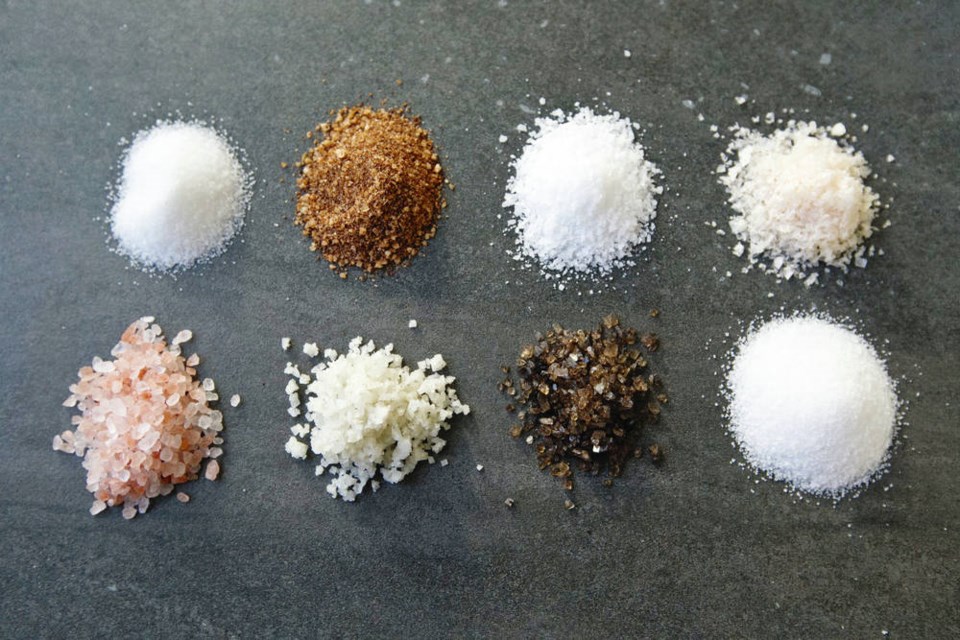Nature Boy has been rinsing his mouth with salt water this past week. He didn’t wait long enough after pizza came out of the oven one evening and bit into a slice while the cheese was blisteringly hot.
Warm salty water helps keep burns clean as they heal.
But this treatment has revealed “cooties” in the salt.
At first, he thought the specks at the bottom of the mug were dishwasher dregs — crumbs baked on at high temperature during the dishwasher’s drying cycle. Close inspection of each mug before use nixed that.
“Pour the water before you add the salt,” I said. The “bits” appeared after the salt was added.
“It could be sand. Or plastic,” I told him. “It’s sea salt. Sea salt contains microplastics.”
Microplastics are pieces of plastic smaller than five millimetres that are formed when plastics break down. Some pieces are very small indeed and can be detected only with a microscope or other fancy equipment.
In recent years, a number of studies have shown that most brands of salt sold as seasoning for food contain microplastics. A 2019 review of the studies showed that 128 salt brands from 38 different regions spanning five continents contain plastic particles.
In 90 per cent of the samples analyzed, microplastic concentrations reached 19,800 particles per kilogram. This means that, just by adding salt to our food, we may be ingesting as many as 36,135 particles every year, based on typical salt-consumption rates.
Sea salt was shown to usually contain the most microplastics, followed by lake salt and mined rock salt, although exceptions were noted. The amount of plastic in a sea-salt brand reflects the amount of microplastic pollution in the ocean region where the salt is made — and we’ve heard a great deal about microplastic pollution in the oceans recently.
Sea salt is made from sea water that is collected and allowed to (or made to) evaporate. What is left after evaporation is sea salt. Coming from the ocean, this also includes whatever minerals and “stuff” that region of ocean contains. In terms of minerals, natural sea salts consist of about 54 per cent chlorine, 30 per cent sodium, 4 per cent magnesium, 2 per cent sulphur, and 1 per cent for each calcium and potassium. The rest comprises 75 or so other trace ocean minerals.
Some brands refine and add to the mix. The package of “fine iodized sea salt” Nature Boy is using to minister to his gums lists other ingredients in addition to “sea salt.” This suggests that this brand may actually be refined sea salt — that is, it’s refined table salt that originated as sea salt, and the brand is marketing those ocean-breeze origins for that special sea-salt cachet.
Among the added ingredients, potassium iodide increases the product’s iodine content, upping its goiter-fighting qualities. Iodine occurs naturally in sea water, but it is unstable and evaporates during refining. Sodium thiosulfate, normally used for treating cyanide poisoning, is added to stabilize the potassium iodide.
Magnesium carbonate and yellow prussiate of soda prevent the salt crystals from clumping. Other brands may add calcium silicate, sodium ferrocyanide, and, less often, aluminum calcium, ammonium citrate, ferric silicon dioxide, magnesium silicate, propylene glycol, silicate, sodium aluminosilicate or calcium phosphate.
Sea salt containing a full sampling of the riches in the sea water it was made from may also contain bits of plastic. We fished a few of the particles out from Nature Boy’s mug. Under a magnifying glass, they certainly looked like plastic.
Table salt is usually sea salt that has been highly refined — heated to high temperatures, processed to extract minerals and bleached to create dry white, uniform crystals. Minerals and anti-caking agents are then added.
The bog-standard refined table salt available at our local grocery store lists dextrose — sugar — among the added ingredients. This seems crazy. And it underscores how sugar is included in almost every processed food available today.
But in salt, sugar stabilizes the potassium iodide, as sodium thiosulfate does.
Salt is more complex than most of us would think. It’s not just sodium chloride. It’s a mix of minerals and chemical elements, with added public health seasonings and a dash of the environment surrounding the source where the salt originates.
Sometimes that includes sugar. Often, it seems, it includes plastic.



